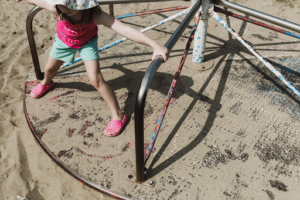 Messy play is an essential part of child development. Our sense of touch, or tactile processing, sends information to our brain about the properties of objects in our environment. Our tactile sense provides vital information skills such as body awareness, academic learning, motor planning, visual discrimination, and social skills. Children can discover and learn more about their world using their hands and feet, which can sometimes lead to getting dirty!
Messy play is an essential part of child development. Our sense of touch, or tactile processing, sends information to our brain about the properties of objects in our environment. Our tactile sense provides vital information skills such as body awareness, academic learning, motor planning, visual discrimination, and social skills. Children can discover and learn more about their world using their hands and feet, which can sometimes lead to getting dirty!
Your child may experience sensory over-responsivity, or observable behavior involving a quick or intense response to a sensory experience that others usually perceive as nonthreatening. This could include becoming upset during activities such as nail clipping, haircuts, bathing, and/or eating. When your child experiences sensory over-responsivity on their feet, you might have noticed them avoiding going barefoot in sand or grass. Helping integrate additional sensory-rich experiences into your child’s life can lead to more engagement and enjoyment with feeding, bathing, and most importantly, play!
Activities to encourage tactile sensory play with hands and feet:
Bubbles: simply having your child popping bubbles is a sensory experience for their hands (and feet!). To incorporate messy play with their feet, you can have your child “wait” until the bubbles hit the ground, and have them pop them by stepping or stomping onto them! This is a great warm-up activity to lead into more sensory-rich play experiences.
Sensory Bins: filling an empty storage bin with objects such as sand or dry beans and placing small toys inside to dig for and interact with provides a fun tactile sensory experience. For an additional sensory experience with the olfactory system, or smell, fill a sensory bin with coffee beans!
Finger Painting: Take away the paintbrushes and bring on the mess! Incorporate various textures into the paint, such as mixing sand into it. Allow your child to create pictures from both their hand and foot prints for an even sensory-filled experience!
Mess-Free Painting: for a tactile experience without the mess, all you will need is a large plastic bag, paint, and masking tape. Place a few drops of paint (multiple colors for a rainbow effect!) inside of the plastic bag and ensure it is sealed. Tape the plastic bag with paint onto a window and allow your child to use their finger to form shapes and pictures on the bag.
If your child dislikes washing their hands and/or dislikes bathing, you can try the following activities:
Wash Station: create a “wash station” in a Tupperware container, small storage bin, or even your sink for a car wash or pet wash with soapy water. This is a great tactile sensory activity for children who don’t enjoy the suds during bath time. Introducing the soapy on a smaller scale (and embedded in play!) will allow them to become more comfortable with the sensory experience.
Shaving Cream: This can be used on a table top or even in the bathtub to contain the mess and with both hands and feet! You can belt out Frozen and build a “snow man” with your child using the shaving cream. Additional Bonus: If you are also working on handwriting or letter formation, you can take off the pressure with pen and paper and practice in the shaving cream!
Water Painting: You can simply give your child a bowl of water and a paintbrush to paint the sidewalk, the fence, and better yet, their body. This activity incorporates the tactile sensory play with water and the feeling of the paintbrush on their skin.
If your child dislikes going to the beach and/or playing in the sandbox you can try the following activities:
Kinetic Sand: Kinetic Sand is available in many themes and variations that may interest your child such as, Frozen, glitter sand, construction zone with trucks, dinosaur fossils, and more! Kinetic Sand has a texture that nearly feels “wet” to the touch; however, it is not and is easily moldable. This is a great activity to incorporate the feet as well, such as making footprints in the sand!
Sugar Castles: using brown sugar is a sweet way to introduce the rough texture of sand! Incorporate measuring cups and popsicle sticks to build sugar castles. This is also a good opportunity to introduce feet into play if your child does not like to walk in the sand at the beach or in a sandbox.
Tips:
1. Start Small: introducing these experiences might be overwhelming, so starting in small amounts can make your child more comfortable to interact with them.
2. Get Out: taking these activities outdoors can alleviate any worries about making a mess inside the home in addition to experience the sensory-rich outdoors!
3. Bring Friends: If your child has a preferred stuffed animal or toy that also has hands and feet, have them tag along! Allowing your child to immerse their preferred toy into sensory play they might initially be hesitant about can be encouraging for them.
4. Join in On the Fun: There is nothing more encouraging or entertaining than your child seeing their caregiver act like a child themselves! Modeling the very play you wish for your child to engage in can be enticing enough for them to participate!
Reagan Lockwood, MOT, OTR/L
Occupational Therapist
Reference: Kranowitz, Carol Stock. (2005). The out-of-sync child: recognizing and coping with sensory processing disorder. New York: A Skylight Press Book/A Perigee Book.
Photo Credit: Sharon McCutcheon via Pexels










 Messy play is an essential part of child development. Our sense of touch, or tactile processing, sends information to our brain about the properties of objects in our environment. Our tactile sense provides vital information skills such as body awareness, academic learning, motor planning, visual discrimination, and social skills. Children can discover and learn more about their world using their hands and feet, which can sometimes lead to getting dirty!
Messy play is an essential part of child development. Our sense of touch, or tactile processing, sends information to our brain about the properties of objects in our environment. Our tactile sense provides vital information skills such as body awareness, academic learning, motor planning, visual discrimination, and social skills. Children can discover and learn more about their world using their hands and feet, which can sometimes lead to getting dirty!